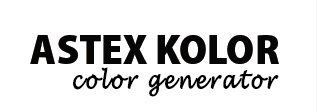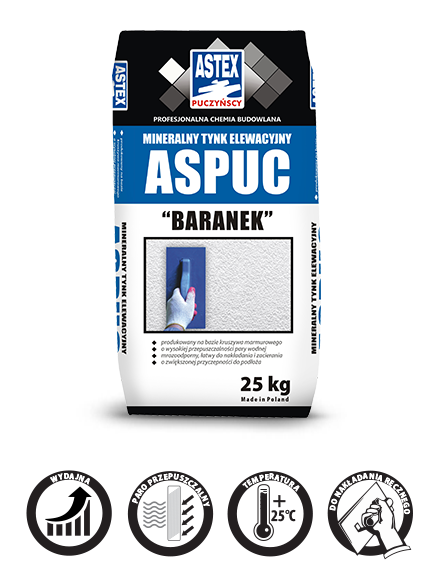Astex Professional Astex-Term thermal insulation system Facade plasters in the thermal insulation system Mineral plasters
ASPUC mineral facade plaster
ASPUC mineral plaster is a mineral, thin-layer, plaster mortar used to perform decorative coatings on the external and internal walls of the building.
- High vapor permeability
- White color
- With the addition of titanium white
- Based on marble aggregate

Calculate expenditure
ziarno 1,5 mm
ziarno 2,0 mm
ziarno 3,0 mm
ziarno 1,5 mm
ziarno 2,0 mm
ziarno 3,0 mm
Expenditure
at the grain thickness of 1.5 mm: 2.5-3 kg per 1m² at the grain thickness of 2.0 mm: 3-3.5 kg per 1m² at the grain thickness of 3.0 mm: 3.5-4 kg per 1m²
Shell life
12 months from the date of production
Packaging
25 kg
Reference document
European Technical Assessment 17/0726
Application
ASPUC mineral plaster is a mineral, thin-layer, plaster mortar used to perform decorative coatings on the external and internal walls of the building. It can be laid on all even surfaces, such as concrete, cement and lime plasters, as well as reinforced layers in ASTEX-TERM insulation systems.
Properties
ASPUC mineral plaster is made on the basis of fillers and marble aggregate 1.5mm 2.0mm 3.0mm thick AND WHITE 52.5 R. CEMENT. It also includes special additives that make it plastic and easy to work with, it has good adhesion to the ground after maturing period (okres wysezonowania) (approx. 21-28 days). It also contains hydrophobic compounds that reduce the absorption of water on the plaster surface and make it resistant to washing.
Substrate preparation
The substrate should be sufficiently strong and even, cleaned of dust, dirt, lime, oils, fats, wax, remains of chalk, lime, oil and emulsion paint. Old paint and plaster coatings with insufficient adhesion should be removed and the defects filled using leveling mortar. Before applying the plaster, the surface should be primed with Akro-Primer-U acrylic primer a minimum of 48 hours before applying the facade mortar. Failure to observe technological breaks between priming the surface and applying the plaster may lead to poorer adhesion and discoloration.
Mortar preparation
ASPUC mineral plaster is prepared by pouring the entire contents of the bag into the water and mixing it manually or mechanically until the desired mortar consistency is obtained. Shortly after mixing, the mortar consistency can be adjusted. The ready mortar is ready to work after approx. 5 minutes and retains its properties for 1.5 hours. During work, it is recommended to mix the mortar from time to time to homogenise the consistency. Remember to apply the same amount of water to each package, otherwise the structure and color of plaster may differ significantly from sample to sample. Too thin mortar can cause problems with troweling and the lack of the desired structure.
Application method
ASPUC plaster is applied to the prepared, primed substrate with a layer of aggregate grain thickness using a smooth stainless steel trowel. Excess material should be removed (stainless steel trowel) from the surface on which the plaster was applied, so as to reduce the effect of mortar pulling behind the plastic trowel as much as possible. The excess mass, formed after being removed from the surface, should be thrown back into the bucket and mixed. The plaster structure is obtained by rubbing with a plastic float. Formed surface of the layer wet rub in order to obtain the desired texture. Rub in a circular motion to one side. The open working time (between application and seizing) depends on the absorbency of the substrate, ambient temperature and the consistency of the mortar. Protect the plastered surface from direct sunlight, wind and rain, and temperature lower than 10 ° C. It is necessary to experimentally (for a given type of substrate and given weather) determine the maximum area that can be made in one technological cycle (stretching and seizing). The material should be applied using the "wet on wet" method, preventing the seized batch from drying before stretching the next one. Otherwise, the location of this connection will be visible. Technological breaks should be planned in advance, e.g. in the corners and bends of the building. The drying time of the plaster depends on the substrate, temperature and relative humidity of air is about 12 to 24 hours. The minimum drying temperature must be above 10 ° C and it is unacceptable to carry out the application of facade plaster, if a decrease in temperature is announced within 24 hours. Too moist air (above 75%) during the plaster drying period and temperatures lower than 10 ° C may negatively affect the final effect of the facade. Typical symptoms of these atmospheric conditions are white blooms and irregular blooms on the wall. The ambient temperature should be + 10 ° C and max. + 25 ° C. If the mortar is intended for
Tools
Drill with a mixer, smooth steel and plastic float. Tools should be cleaned with clean water directly after use.
Storage and transport
The plaster should be transported and stored in tightly sealed bags, in dry conditions (preferably on pallets). Protect from moisture. The shelf life is 12 months from the date of manufacture on the packaging.
Technical data
Mixture proportions 0.18 - 0.22 L water per 1 kg. Mixture proportions 4.50 - 5.50 L water per 25 kg. Mortar ready to work 1.5 hours. Open work time approx. 20 minutes. Mortar preparation temperature from + 5 ° C to + 25 ° C. Substrate temperature from + 5 ° C to + 25 ° C. Ambient temperature when applying plaster from + 10 ° C to + 25 ° C
Caution
ASTEX- PUCZYŃSCY PLASTERS PAINTS guarantees and bears responsibility for the quality of the product, but has no influence and is not responsible for the manner of use and conditions in which it was used. The recommendations and scope of use of the product or method of performance does not release the contractor from carrying out work in accordance with the principles of building art and health and safety regulations. If in doubt as to the use of the product, please contact us at Tel. 0 54 283 21 24 or by e-mail to the address: laboratory@astex-tynki.pl
Do you have questions? Doubts? Ask an advisor Contact form













